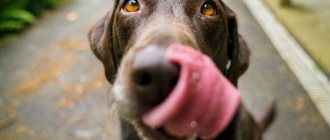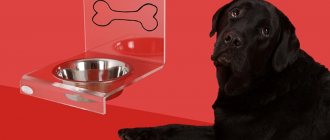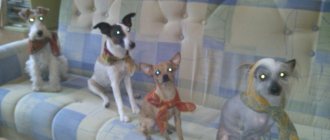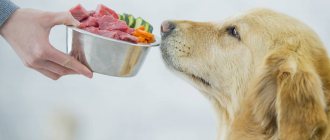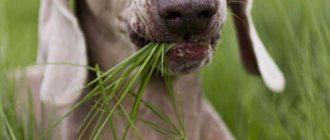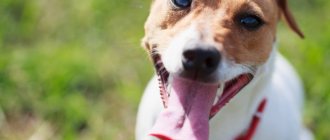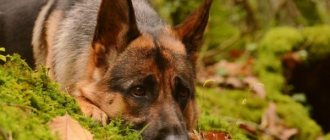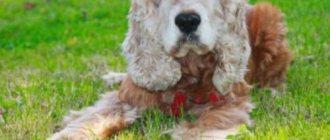Most dogs have a good appetite. Refusal of your favorite food is a signal to the owner that you need to closely monitor the pet’s further eating behavior. True, among dogs there are also those who by nature are small-fed and capricious in food. Therefore, not any refusal to eat should cause panic. From the article you will learn in which cases you should immediately contact a veterinarian to find out the cause of the “hunger strike,” and when you can let go of the situation and observe a little.
Reasons why a dog refuses food
First of all, it is worth finding out whether the dog maintains normal activity, or whether he is lethargic and refuses even treats.
While remaining active
An active animal almost never refuses food or treats, even in the absence of hunger.
Possible reasons for refusing to eat while maintaining active behavior:
- intensive growth. The question often arises: why does a healthy puppy refuse to eat? If your baby misses one or two meals, it’s okay. It grows, the number of necessary feedings gradually decreases;
- picky. This is especially true for miniature breeds, which are often capricious and choose tastier food. By refusing food, such dogs simply expect a more tasty offering;
- serious physical activity. Dogs tend to refuse to eat if they have undergone intense exercise or training the day before;
- influence of hormones. Often in females in heat I ignore the food bowl. The same applies to male dogs if you meet a female in heat while out for a walk;
- stressful situation. Dogs can experience stress from a variety of situations: moving to a new home, traveling by car, going to the vet, staying in a pet hotel for a certain period of time. The dog may refuse both food and water.
- not a suitable menu. A pet, for example, refuses to eat dry food. There may be several reasons: the product has spoiled and is bitter, the diet is simply not to your liking, or the dog is lacking water.
All of the above reasons, provided the dog is active, cannot last long. When replacing food or after some time, the dog will still show interest in the bowl.
The dog is lethargic and does not eat
If the dog becomes more and more lethargic, spends more time in his place, refuses to play and does not happily run for a walk, this is a reason to contact the veterinarian. Although, there are dogs with a phlegmatic temperament, which are absolutely not characterized by jumping and joyfully running around the house. Every owner is able to notice changes in behavior almost immediately; all you have to do is be a little more attentive.
It’s worth doing a test - hand your beloved dog a piece of his favorite treat. If he reaches for food, but at the last moment refuses it, visit the veterinarian immediately. Most likely, he cannot swallow his favorite food due to nausea or injury. Nausea may indicate intoxication of the body and developing diseases.
Important: do not delay visiting the clinic - many diseases develop too quickly and you may simply not have time to provide help.
Danger to humans
In most cases, caring for a sick dog does not pose a danger to its owner. It is better to maintain a certain distance only in case of the following diseases
:
- Worm infestations
. Any living organism can become infected with worms. Do not forget about personal protective equipment during treatment.
- Encephalitis
. Ixodid ticks quickly change their host and do not disdain human blood at all.
- Rabies
. Be sure to isolate the infected person before visiting the veterinarian. Rabies is treated only in a hospital. If bitten, seek medical attention immediately. To stop harmful viruses you will have to make 6 injections.
- Leptospirosis
. Infection with the bacterium can be determined by a putrid odor, rapid weight loss and bleeding from the mouth.
- Ringworm
. _ When eliminating microscopic fungi, you will have to wear special protective gloves to prevent direct contact with the body of the infected person. - Toxoplasmosis
. Toxoplasma poses a particular danger to pregnant women. For safety, the dog is placed in a hospital.
All other possible diseases do not pose a danger to humans.
Diseases that cause your pet to refuse to eat
Almost all diseases force the dog to refuse to eat, as they cause pain, fever, and nausea. Some of them can provoke both refusal to eat and excessive appetite against the background of general lethargy. For example, in the case of a helminthic infestation, a dog may eat a lot, but still lose weight.
There is a large group of diseases that can cause a dog to lose his appetite:
- diseases of the mouth (stomatitis, gingivitis, periodontitis, tartar, etc.);
- foreign body in the pharynx or gastrointestinal tract - the situation requires emergency medical intervention. Usually, in such a situation there is no stool and vomiting;
- ear diseases, especially in the acute period;
- problems with the gastrointestinal tract (gastritis, intestinal obstruction, volvulus);
- poisoning;
- injuries that cause severe pain;
- viral and bacterial infections;
- oncological diseases;
- infection by parasites: helminthic infestations, fleas, ticks, lice eaters, etc.;
- diabetes;
- renal, liver failure;
- stress;
- colds. Many owners believe that the animal can easily sleep in a draft and a cold floor and not have colds. This is wrong. If a dog has a cold, he will refuse food, but not water. Without treatment, the disease will lead to complications or death of the pet.
It should be noted that the dog’s stress should go away in a couple of days. If this does not happen, you should consult a doctor to prescribe sedatives or advice on how to mitigate the consequences.
Diagnosis and treatment of possible diseases
If the dog does not eat and is lethargic, this is just a symptom. Full recovery is possible only after diagnosis and selection of an individual treatment plan based on the cause. Veterinarians recommend examination even if physiological factors are suspected.
When making a diagnosis use:
- visual examination and history taking necessary for a complete clinical picture;
- study of general and biochemical analysis of blood and urine, determining changes in basic indicators;
- Ultrasound of the abdominal cavity and x-ray, which helps determine the condition of internal organs and the presence of formations.
If standard research methods do not help, then additional ones are used: biopsy, colonoscopy, bacterial culture and others.
First aid to the victim
With sunstroke
it is necessary to lower body temperature. Move your pet into the shade and wet the belly, outside of the ear, and paw pads with cold water.
If you suspect poisoning, call a doctor and use the following tips before the team arrives:
- Determine the frequency of gagging.
- Assess the color and consistency of the vomit and inspect it for foreign matter.
- Make sure you have enough clean drinking water. If water stimulates new bouts of vomiting, remove it.
- Sweeten your water to raise your glucose levels. If the dog is unable to drink on its own, pour water into it through a syringe without a needle.
- Avoid feeding.
Avoid taking antiemetic drugs. Vomiting is a natural way to cleanse the body of toxins. Blocking it can lead to serious poisoning of the body.
If your pet has lost consciousness
– lay him on his side and open his jaw. This will prevent you from choking on vomit. You can’t wait for a veterinarian in only one case – poisoning in front of your eyes. To remove toxins, the dog must be given a laxative or activated charcoal.
When neutralizing a tick
Be sure to wear protective gloves. The parasite can be pulled out with your fingers or tweezers from a manicure set. Gently grab the tick where it penetrates the skin and unscrew it in a smooth clockwise motion. Avoid sudden movements and vertical stretching. After a successful operation, apply an antiseptic to the bite site. Place the parasite in a jar and take it to a veterinary clinic for diagnosis. Do not give your dog anti-itch medications before visiting the doctor. This will blur the clinical picture and make diagnosis difficult.
When self- treating an external wound
clean it of dirt and foreign objects. Remove damaged skin to prevent it from dying and infecting healthy areas. Rinse the wound under running water and treat with an antiseptic solution. Tighten the edges of the wound and secure with a sterile bandage. If the wound is wide and deep, clamp the vessels with a tourniquet and immediately take the victim to the clinic.
dermatitis is suspected
It is prohibited to treat affected skin or cut hair. Blurring the symptoms will interfere with the correct diagnosis. If you want to help and relieve the itching, give an antihistamine.
Ways to regain appetite
If no pathologies are found, then try to restore your appetite using the following tips
:
- Skip a few feedings. Do not change food or usual products. If the pet is spoiled, then the problem will be solved by a banal feeling of hunger. Remember that giving in to provocations and giving out treats is prohibited.
- Remove food immediately after your dog eats. If you only eat a few grains of food, don’t worry. Not having a constant source of food will only whet your appetite.
- Treat your dog to fish. 10 minutes before feeding, feed your pet a small piece of lightly salted fish. Salt increases the production of gastric juice and stimulates hunger. Do not make this trick permanent and be sure to consult your veterinarian. Salty food is harmful to four-legged pets. In the presence of chronic diseases, even a small amount can cause a relapse.
- Increase the frequency and total time of walking. This will help work up an appetite. If your dog is not eating well and is lethargic, active walks will cheer him up.
- Change your diet. Change your usual cereal, type of meat or offal. Too monotonous food quickly gets boring. Avoid monofeeding.
- Feed food to another animal in front of your picky dog. Animals don't like to share their food, so this trick is very effective.
If the condition does not return to normal within 1-2 weeks, undergo a re-examination. Some diseases are difficult to diagnose in the early stages even with the help of special equipment. The dog does not eat for a long time due to a disease that is not always obvious. Whims and stress do not last long.
Types of therapy
In the treatment of intussusception
surgical intervention is used. This type of intestinal obstruction is accompanied by the blocking of the lumen of one part of the intestine by another. It is impossible to cure the victim solely with medication. After surgery, antibiotics and anti-inflammatory drugs are prescribed.
In addition to intestinal blockage, any disorder in the liver
– hepatocytes.
Their poisoning and destruction occurs under the influence of toxins secreted by parasites or viruses. The likelihood of liver failure and blood poisoning increases. In such cases, the recommended course
:
- hepatoprotectors that restore damaged hepatocytes;
- immunomodulators and vitamins that stimulate the functioning of immune cells;
- antibiotics that destroy the pathogen;
- anti-inflammatory drugs that eliminate inflammatory processes inside the body.
In case of poisoning
it is important to eliminate intoxication, reduce the level of acidity in the stomach, relieve pain spasms and slow down the gag reflex. For severe dehydration, saline drips are prescribed. A dangerous poison that has entered the victim’s body is suppressed by introducing an antidote. Toxins are removed using sorbents and diuretics.
Before treatment for helminthic infestation
it is necessary to determine the type of parasite. Typically, female worms lay eggs near the anus, so stool analysis is used for diagnosis. When infected with helminths, it is important to restore the functionality of the affected organs, remove parasites and minimize possible complications. It is recommended to use anthelmintic suspensions and pastes for puppies, and tablets for adult animals. Due to the risk of infection, the owners must also take an anthelmintic.
Anti-mite therapy
takes from 1 to 2 months. Only the extreme stage of encephalitis cannot be treated. In other cases, the victim is prescribed hepatoprotectors, acaricidal, antihistamines and diuretics. In case of severe intoxication, blood transfusion is recommended. Mandatory sterilization is provided for those who have recovered from demodicosis. The disease is inherited, so such individuals are discarded from breeding.
Speed of recovery from injuries
depends on their severity. The victim is prescribed analgesics and anti-inflammatory drugs. For some bruises, warming with a blue lamp or a warm heating pad is recommended. Scratching the wound is avoided by wearing a special collar.
For animals with cancer
radiation or chemotherapy, a course of antibiotics and immunomodulators are provided. The tumor is removed with a scalpel, laser or freezing. In the final stages, the disease is considered incurable. Euthanasia is recommended.
Treatment of dermatological diseases
carried out at home. Antifungal or antibacterial drugs, corticosteroids and antihistamines are prescribed. If skin problems are caused by an allergic reaction, allergen-specific immunotherapy (ASIT) is recommended. This technique involves injecting a diluted allergen with a gradual increase in its concentration. ASIT develops immunity and reduces the strength of the allergic reaction.
Tartars
eliminated by ultrasonic cleaning. The procedure is performed without anesthesia. Pain relief is allowed for excessive aggression or fear. More complex manipulations involving filling, restoration of a broken tooth or its removal are carried out exclusively under anesthesia. After restoring diseased teeth, dentists recommend regular brushing, dry feeding, and rubber toys that clean the enamel during chewing.
Diet
Regardless of the diagnosis, the animal must be put on a therapeutic diet. A fast is recommended for the first 24 hours. Monitor the amount of clean water. It helps remove toxins. On the second day, gradual introduction of light and liquid food is allowed. The safest dish option is chicken broth. After the vomiting disappears, offer your pet oatmeal or rice porridge. Boil chicken or turkey fillet, add cooked vegetables and fresh herbs.
Feed the patient in small but frequent portions 5-6 times a day. As you feel better, introduce new foods. All food offered must be warm and fresh. If a portion remains uneaten, throw it away and prepare a new one. Returning to the previous diet is acceptable if good health lasts more than 3 days - but not in the case of poisoning and gastrointestinal disorders.
What should the owner do?
The main thing is constant observation. It needs to be organized in such a way as to monitor the condition of the animal throughout the day. During this period, it is worth repeatedly offering the dog fresh food; it may be rejected due to spoilage. For example, soaked dry food should not be left in a bowl during the day. Sour pellets cause many animals to stop eating.
Important: you must contact a veterinary clinic no later than 36 hours after an adult dog refuses to eat; for a puppy, this period is 48 hours. These are the extreme recommended time periods. It would be better if the appeal happens even faster.
How to improve your appetite
Are you sure your pet is absolutely healthy? Then it's time to take drastic measures. It is important to do the following:
Create a daily schedule
Feed your pet at the same time so that he gets used to it. Dogs are conservatives; order in everything is important to them. Remember that puppies need to be fed frequently.
Eliminate free access
A full bowl is left only for those animals that do not have any problems with appetite. If your pet eats too little, you need to create an artificial food deficit. Make your ward wait for each feeding so that his appetite wakes up at a certain time.
Limit your time
Leave the bowl for 10-15 minutes only. It doesn't matter whether the companion has eaten or not. Once the time is up, put the dishes away. Just don’t interfere with your pet’s eating.
Provide your dog with exercise
It is important to let your puppy get rid of excess energy and emotions. This will protect the house from destruction, make the pet more obedient and improve its appetite.
Control your portion sizes
There is one little trick: at some point, reduce the amount of food to ¾ of the previous amount, and then gradually add more. In this way you can increase the portion by 1.5 times. Just take your time, otherwise the dog will go on hunger strike again.
Owner's observations
When contacting, it is worth helping the veterinarian in collecting data. I arrive at the clinic armed with detailed information about the dog’s condition. For this purpose, records are kept during the observation period, where they include:
- data on diet, selected food;
- presence or absence of vaccinations, recent antiparasitic treatments;
- date and approximate time of the first refusal of a portion;
- information about the dog's refusal of all foods or selective fasting;
- information about the ability to swallow food. At the very beginning of the refusal, offer a treat; here it is important to understand whether the dog has the opportunity to swallow what is offered; there are also difficulties with the process;
- The animal also refuses water or drinks greedily and cannot get drunk;
- observations of the dog's stool: presence or absence, diarrhea, change in color, shape;
- the presence or absence of vomiting or urge. If available, record color, frequency and consistency.
You can remember all the information if you wish, but, most likely, the owner himself will experience stress when visiting a doctor. Therefore, recording observational data is more reliable. Such information will greatly facilitate the process of examination and diagnosis and save valuable time.
Fluid intake norms for an animal
The daily water intake for a dog depends on its weight, physical activity and time of year.
With a fairly active lifestyle in normal, not hot weather, 1 kg of dog’s body weight should include 20-70 ml of clean water per day.
In cases where the dog is undergoing intense training, is in a hot climate, or is ill with an increase in body temperature, the volume of fluid should be increased two to three times.
The daily water intake does not include liquid food and other drinks other than clean drinking water.
The animal needs to drink a certain amount of fluid every day
First aid
The main assistance should be the timely delivery of the dog to the clinic. If you are sure of the cause of the illness, you can take some measures. For example, in case of poisoning, it is possible to give the dog an antiemetic, sorbents (Enterosgel, Polysorb), antispasmodics (no-spa). Do not forget to warn the specialist about the first aid measures taken, be sure to write down or remember the nuances.
Important: in emergency situations, you have to visit any veterinary clinic where people are unfamiliar with the dog’s health condition and, for example, treatment regimens for chronic diseases. Don't forget to tell your doctor about the medications you are taking, which may cause you to refuse to eat.
To avoid such situations, consult a veterinarian before using the drug.
After collecting data, the clinic will prescribe tests and conduct research. Only based on their results can treatment be prescribed. It is unacceptable to prescribe treatment on your own, or use folk remedies or medications. Such actions will cause additional harm to the dog’s health without eliminating the root cause of refusal to eat.
Briefly about the main thing
- A healthy animal can refuse food for various reasons, but for no more than 36 hours;
- A doctor is consulted 36 hours after refusal for an adult dog, 48 for puppies;
- If the dog is lethargic, refuses food and, possibly, water, it is necessary to immediately visit a veterinary hospital;
- The doctor needs to provide observation data about the pet, starting from the very first refusal of food;
- All prescribed treatment regimens for the animal’s chronic diseases are brought to the hospital.
Do your pets often refuse a full bowl? What are the reasons for a hunger strike? How did you solve the problem? And who has the little dog of the dog world living at home? Tell us about your experience in the comments. Your opinion is important and interesting to us.
Prevention
Follow the schedule of vaccinations, treatments for parasites, and be examined by a doctor (dispensary examination) at least once a year. Medical examination is especially important for pets over 6 years old, because by this age most dog breeds are elderly, and it is necessary to regularly evaluate the functioning of their body.
Do not ignore recommendations on animal hygiene for dogs, such as washing bowls, a suitable bed that needs to be washed and patted regularly, feeding and watering standards. The food must be fresh and of high quality, the water must be clean and filtered. And many foods familiar to humans are poisonous to dogs - for example, grapes (and raisins), chocolate, avocados, spices, pickles, sausages, mushrooms, onions, garlic, alcohol. They need to be excluded from the dog’s diet once and for all.
Eliminate hazards at home, put household chemicals and medicines in locked cabinets, and if your dog is cunning and can open them, you need to hang a lock. Buy toys according to the size and character of the dog so that it does not swallow or chew them. Close the windows and balcony, dogs also jump from heights. Clean your home regularly.
And, of course, don’t forget about friendship with your dog. You mean the whole world to her, and she is always waiting for you to walk with her, play, pet her and chat. If you don't have enough time for a pet and you think she's bored, get a second one, they'll have more fun together.
Check your dog regularly – eyes, ears, fur, mouth. Use veterinary cosmetics for your pet’s hygiene and do not forget that the veterinarian is your assistant in caring for your dog.
